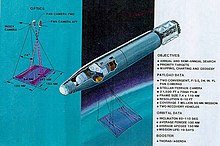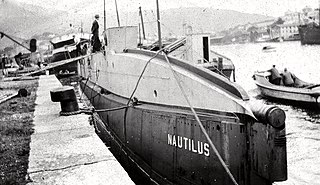
USS O-12 (SS-73) was an O-class submarine of the United States Navy. These later O-boats, O-11 through O-16, were designed by Lake Torpedo Boat to different specifications than the earlier Electric Boat designs. They performed poorly as compared to the Electric Boat units, and are sometimes considered a separate class. The ship was launched in 1917 and entered service with the Navy in 1918 in the Panama Canal Zone.

USS Skate (SSN-578) was the third submarine of the United States Navy named for the skate, a type of ray, was the lead ship of the Skate class of nuclear submarines. She was the third nuclear submarine commissioned, the first to make a completely submerged trans-Atlantic crossing, the second submarine to reach the North Pole, and the first to surface there.
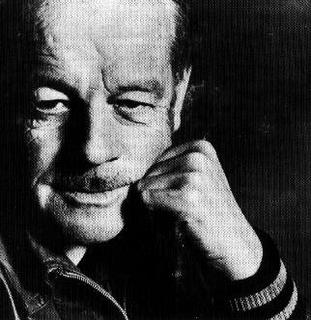
Alistair Stuart MacLean was a Scottish novelist who wrote popular thrillers and adventure stories. Many of his novels have been adapted to film, most notably The Guns of Navarone (1957) and Ice Station Zebra (1963). In the late 1960s, encouraged by film producer Elliott Kastner, MacLean began to write original screenplays, concurrently with an accompanying novel. The most successful was the first of these, the 1968 film Where Eagles Dare, which was also a bestselling novel. MacLean also published two novels under the pseudonym Ian Stuart. His books are estimated to have sold over 150 million copies, making him one of the best-selling fiction authors of all time.

USS Nautilus (SSN-571) was the world's first operational nuclear-powered submarine and the first submarine to complete a submerged transit of the North Pole on 3 August 1958. Her initial commanding officer was Eugene "Dennis" Wilkinson, a widely respected naval officer who set the stage for many of the protocols of today's Nuclear Navy of the US, and who had a storied career during military service and afterwards.

The submarine film is a subgenre of war film in which the majority of the plot revolves around a submarine below the ocean's surface. Films of this subgenre typically focus on a small but determined crew of submariners battling against enemy submarines or submarine-hunter ships, or against other problems ranging from disputes amongst the crew, threats of mutiny, life-threatening mechanical breakdowns, or the daily difficulties of living on a submarine.
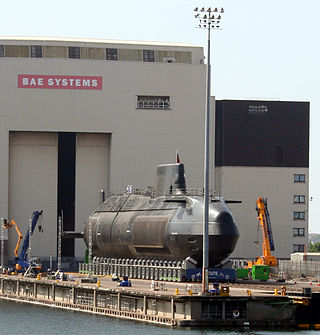
A nuclear submarine is a submarine powered by a nuclear reactor, but not necessarily nuclear-armed. Nuclear submarines have considerable performance advantages over "conventional" submarines. Nuclear propulsion, being completely independent of air, frees the submarine from the need to surface frequently, as is necessary for conventional submarines. The large amount of power generated by a nuclear reactor allows nuclear submarines to operate at high speed for long periods, and the long interval between refuelings grants a range virtually unlimited, making the only limits on voyage times being imposed by such factors as the need to restock food or other consumables.

Voyage to the Bottom of the Sea is a 1961 American science fiction disaster film, produced and directed by Irwin Allen, and starring Walter Pidgeon and Robert Sterling. The supporting cast includes Peter Lorre, Joan Fontaine, Barbara Eden, Michael Ansara, and Frankie Avalon. The film's storyline was written by Irwin Allen and Charles Bennett. The opening title credits theme song was sung by Avalon. The film was distributed by 20th Century Fox.

Bear Island is a thriller novel by Scottish author Alistair MacLean. Originally published in 1971 with a cover by Norman Weaver, it was the last of MacLean's novels to be written in first-person narrative. This novel is a murder mystery with the added twist that the scene of the crimes is Bear Island, an island in the Svalbard archipelago of the Norwegian Arctic.

Yamal is a Russian Arktika-class nuclear-powered icebreaker operated by Atomflot. She is named after the Yamal Peninsula in Northwest Siberia; the name means End of the Land in Nenets.

Sir George Hubert Wilkins MC & Bar, commonly referred to as Captain Wilkins, was an Australian polar explorer, ornithologist, pilot, soldier, geographer and photographer. He was awarded the Military Cross after he assumed command of a group of American soldiers who had lost their officers during the Battle of the Hindenburg Line, and became the only official Australian photographer from any war to receive a combat medal. He narrowly failed in an attempt to be the first to cross under the North Pole in a submarine, but was able to prove that submarines were capable of operating beneath the polar ice cap, thereby paving the way for future successful missions. The US Navy later took his ashes to the North Pole aboard the submarine USS Skate on 17 March 1959.

Firefox is a thriller novel written by Craig Thomas and published in 1977. The Cold War plot involves an attempt by the CIA and MI6 to steal a highly advanced experimental Soviet fighter aircraft. The chief protagonist is fighter pilot turned spy Mitchell Gant. The book was subject to a 1982 film adaptation produced and directed by Clint Eastwood who also played the role of Gant in the film.
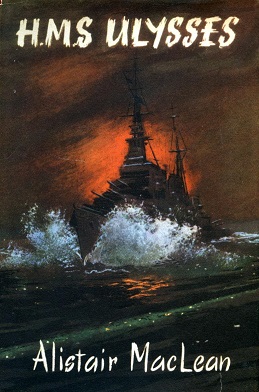
HMS Ulysses was the debut novel by Scottish author Alistair MacLean. Originally published in 1955, it was also released by Fontana Books in 1960. MacLean's experiences in the Royal Navy during World War II provided the background and the Arctic convoys to Murmansk provided the basis for the story, which was written at a publisher's request after he'd won a short-story competition the previous year.

Santorini is the final novel by Scottish author Alistair MacLean, first published in 1986.

A drifting ice station is a temporary or semi-permanent facility built on an ice floe. During the Cold War the Soviet Union and the United States maintained a number of stations in the Arctic Ocean on floes such as Fletcher's Ice Island for research and espionage, the latter of which were often little more than quickly constructed shacks. Extracting personnel from these stations proved difficult and in the case of the United States, employed early versions of the Fulton surface-to-air recovery system.
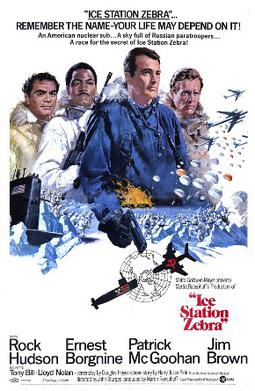
Ice Station Zebra is a 1968 American espionage thriller film directed by John Sturges and starring Rock Hudson, Patrick McGoohan, Ernest Borgnine, and Jim Brown. The screenplay is by Douglas Heyes, Harry Julian Fink, and W. R. Burnett, loosely based on Alistair MacLean's 1963 novel. Both have parallels to real-life events that took place in 1959. The film concerns a US nuclear submarine that must rush to the North Pole to rescue the members of the Ice Station Zebra.
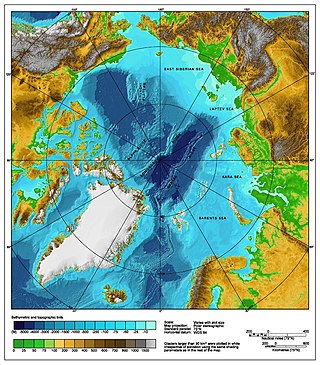
Arktika 2007 was a 2007 expedition in which Russia performed the first ever crewed descent to the ocean bottom at the North Pole, as part of research related to the 2001 Russian territorial claim, one of many territorial claims in the Arctic, made possible, in part, because of Arctic shrinkage. As well as dropping a titanium tube containing the Russian flag, the submersibles collected specimens of Arctic flora and fauna and apparently recorded video of the dives. The "North Pole-35" manned drifting ice station was established.
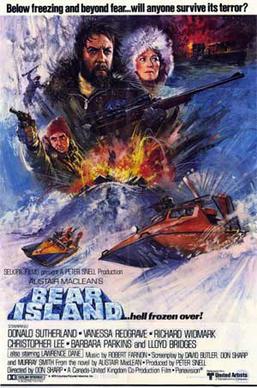
Bear Island is a 1979 thriller film loosely based on the 1971 novel Bear Island by Alistair MacLean. It was directed by Don Sharp and starred Donald Sutherland, Vanessa Redgrave, Richard Widmark, Christopher Lee and Lloyd Bridges.
The Undersea Adventures of Captain Nemo is a Canadian animated television series of five-minute cartoons produced in 1975 by Rainbow Animation in Toronto, Ontario. The series follows the underwater adventures of Captain Mark Nemo and his two young assistants, Christine and Robbie, in their nuclear-powered submarine, the Nautilus.
Operation Sunshine was a scientific expedition conducted by the United States Navy in the summer of 1958. A crew of just over 100 sailors piloted USS Nautilus (SSN-571) under the North Pole. Nautilus was chosen for the mission because her nuclear reactor allowed her to remain submerged longer than a conventional submarine. The mission was completed successfully on August 3, 1958, when Nautilus and crew crossed under the North Pole.


